GRAD 695: Applying Agile Principles in Healthcare Quality of Care
VerifiedAdded on 2022/12/27
|19
|4991
|84
Report
AI Summary
This report, prepared by a student for Harrisburg University's GRAD 695 PGMT course, investigates the implementation of agile principles within the healthcare industry to enhance the quality of patient care. The research highlights the complex nature of hospitals as dynamic systems and emphasizes the need for organizational structures and processes that combine internal efficiency with external effectiveness. The report identifies key problems such as IT management issues, rising healthcare costs, and regulatory challenges, and proposes agile management as a potential solution. It reviews the four core values of the agile framework (Individuals and Interactions Over Processes and Tools, Working Software Over Comprehensive Documentation, Customer Collaboration Over Contract Negotiation, and Responding to Change Over Following a Plan) and explores how agile project management can optimize healthcare processes. The report includes a literature review, problem statement, proposed solution approach, and conclusion, underscoring the potential benefits of agile methodologies in addressing issues such as increasing healthcare demands and the need for affordable, high-quality services. The study emphasizes the iterative nature of agile project management, which allows healthcare organizations to develop, test, and refine solutions to achieve desired outcomes. The report also acknowledges limitations, such as the lack of primary data, and suggests future research directions.
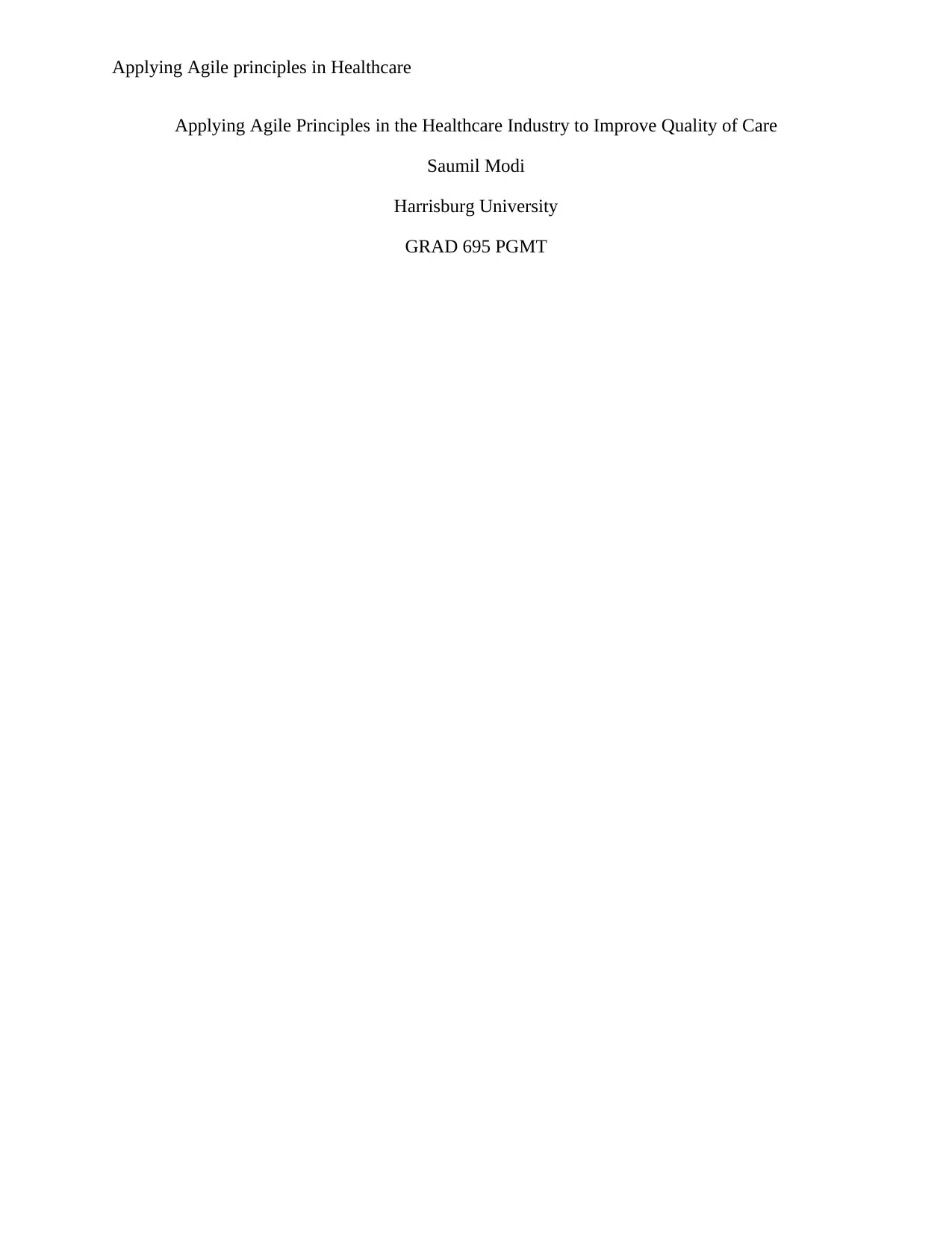
Applying Agile principles in Healthcare
Applying Agile Principles in the Healthcare Industry to Improve Quality of Care
Saumil Modi
Harrisburg University
GRAD 695 PGMT
Applying Agile Principles in the Healthcare Industry to Improve Quality of Care
Saumil Modi
Harrisburg University
GRAD 695 PGMT
Paraphrase This Document
Need a fresh take? Get an instant paraphrase of this document with our AI Paraphraser
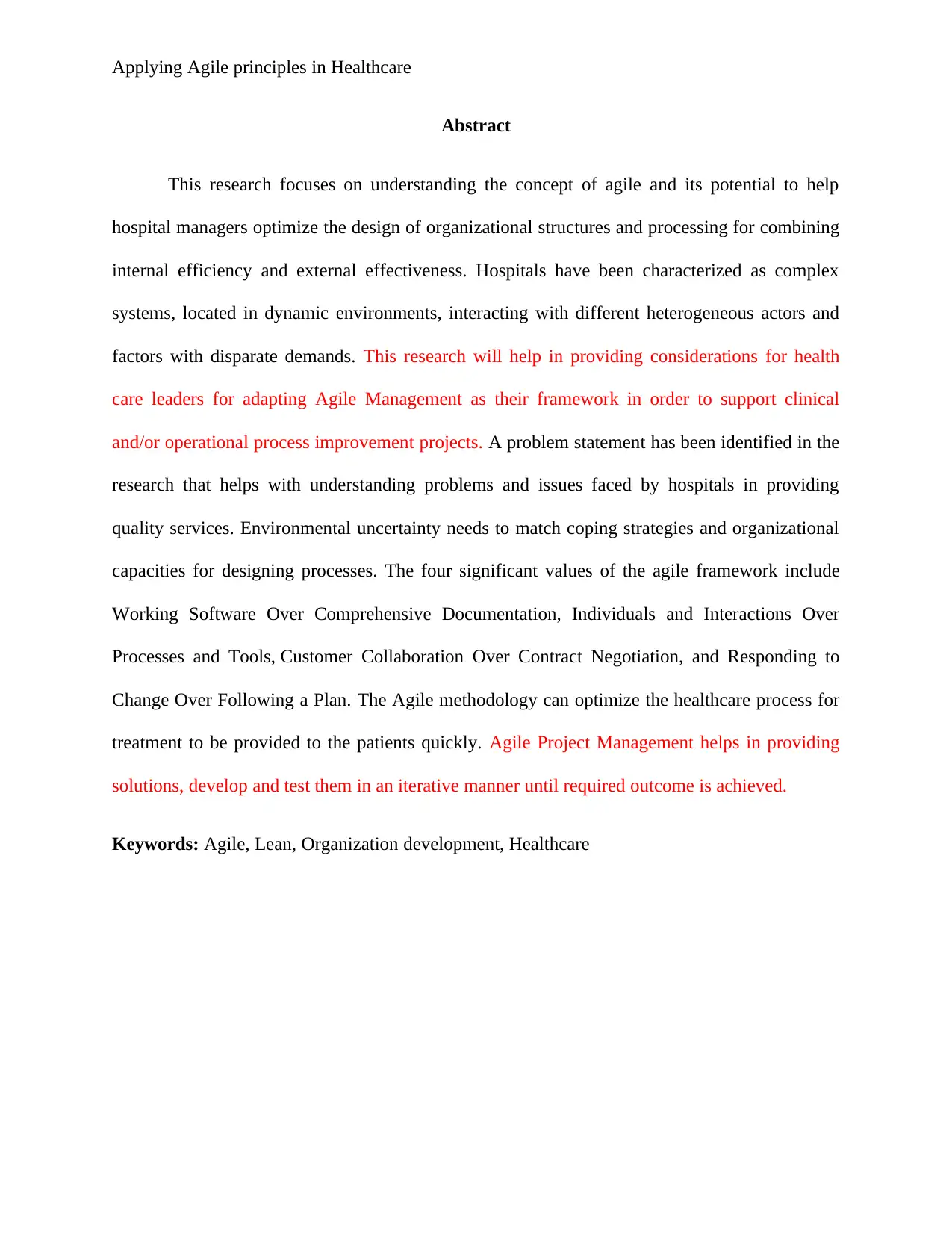
Applying Agile principles in Healthcare
Abstract
This research focuses on understanding the concept of agile and its potential to help
hospital managers optimize the design of organizational structures and processing for combining
internal efficiency and external effectiveness. Hospitals have been characterized as complex
systems, located in dynamic environments, interacting with different heterogeneous actors and
factors with disparate demands. This research will help in providing considerations for health
care leaders for adapting Agile Management as their framework in order to support clinical
and/or operational process improvement projects. A problem statement has been identified in the
research that helps with understanding problems and issues faced by hospitals in providing
quality services. Environmental uncertainty needs to match coping strategies and organizational
capacities for designing processes. The four significant values of the agile framework include
Working Software Over Comprehensive Documentation, Individuals and Interactions Over
Processes and Tools, Customer Collaboration Over Contract Negotiation, and Responding to
Change Over Following a Plan. The Agile methodology can optimize the healthcare process for
treatment to be provided to the patients quickly. Agile Project Management helps in providing
solutions, develop and test them in an iterative manner until required outcome is achieved.
Keywords: Agile, Lean, Organization development, Healthcare
Abstract
This research focuses on understanding the concept of agile and its potential to help
hospital managers optimize the design of organizational structures and processing for combining
internal efficiency and external effectiveness. Hospitals have been characterized as complex
systems, located in dynamic environments, interacting with different heterogeneous actors and
factors with disparate demands. This research will help in providing considerations for health
care leaders for adapting Agile Management as their framework in order to support clinical
and/or operational process improvement projects. A problem statement has been identified in the
research that helps with understanding problems and issues faced by hospitals in providing
quality services. Environmental uncertainty needs to match coping strategies and organizational
capacities for designing processes. The four significant values of the agile framework include
Working Software Over Comprehensive Documentation, Individuals and Interactions Over
Processes and Tools, Customer Collaboration Over Contract Negotiation, and Responding to
Change Over Following a Plan. The Agile methodology can optimize the healthcare process for
treatment to be provided to the patients quickly. Agile Project Management helps in providing
solutions, develop and test them in an iterative manner until required outcome is achieved.
Keywords: Agile, Lean, Organization development, Healthcare
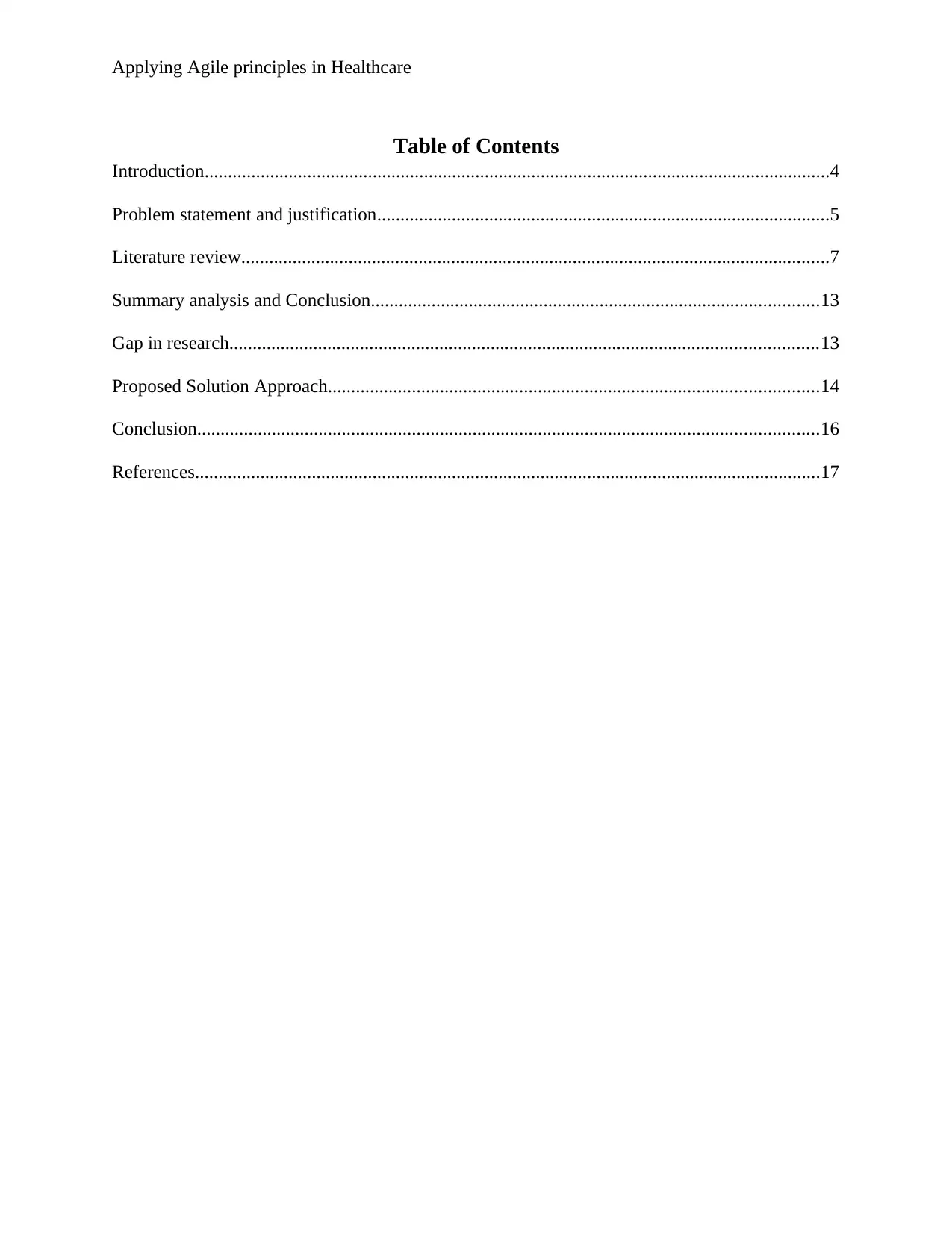
Applying Agile principles in Healthcare
Table of Contents
Introduction......................................................................................................................................4
Problem statement and justification.................................................................................................5
Literature review..............................................................................................................................7
Summary analysis and Conclusion................................................................................................13
Gap in research..............................................................................................................................13
Proposed Solution Approach.........................................................................................................14
Conclusion.....................................................................................................................................16
References......................................................................................................................................17
Table of Contents
Introduction......................................................................................................................................4
Problem statement and justification.................................................................................................5
Literature review..............................................................................................................................7
Summary analysis and Conclusion................................................................................................13
Gap in research..............................................................................................................................13
Proposed Solution Approach.........................................................................................................14
Conclusion.....................................................................................................................................16
References......................................................................................................................................17
⊘ This is a preview!⊘
Do you want full access?
Subscribe today to unlock all pages.

Trusted by 1+ million students worldwide
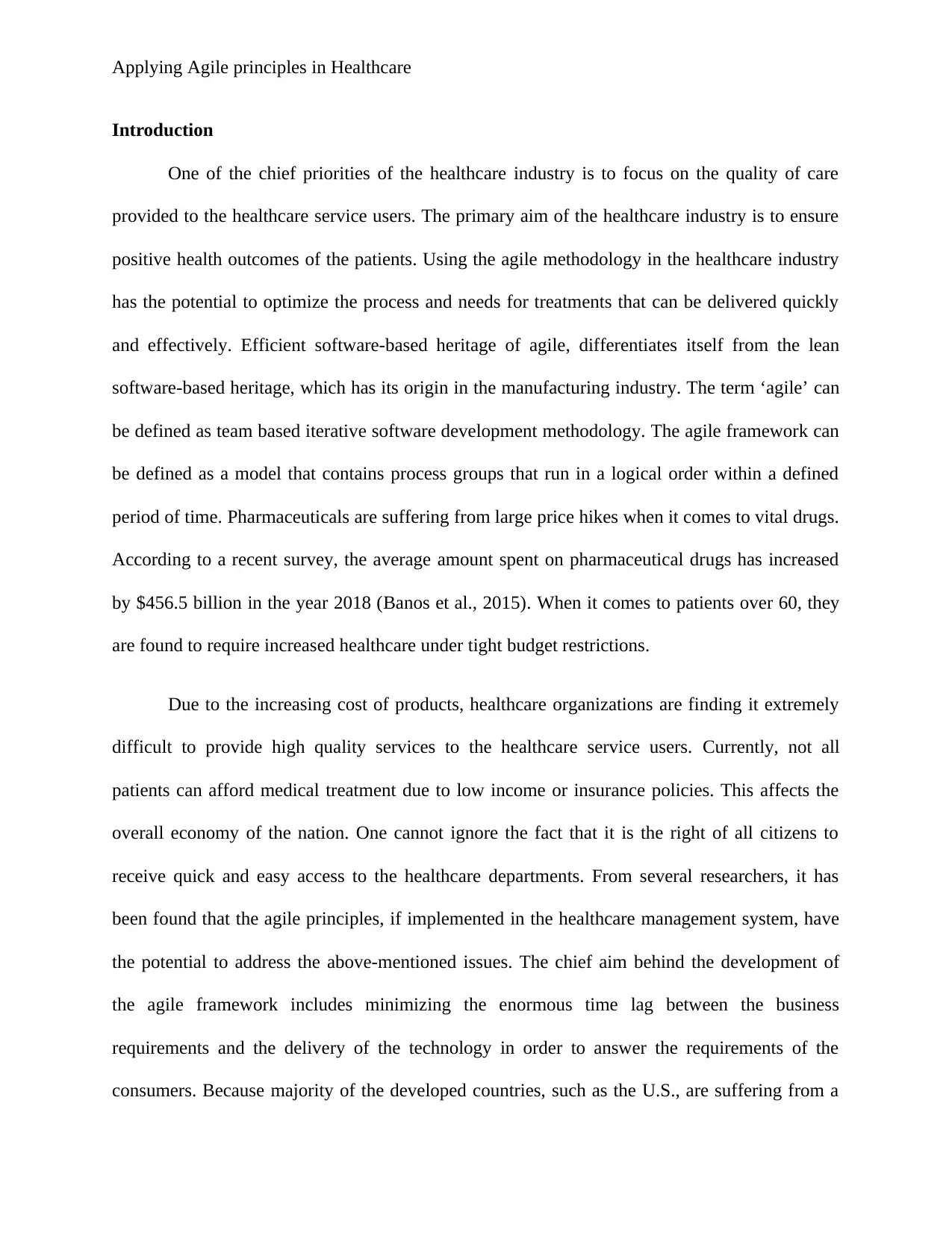
Applying Agile principles in Healthcare
Introduction
One of the chief priorities of the healthcare industry is to focus on the quality of care
provided to the healthcare service users. The primary aim of the healthcare industry is to ensure
positive health outcomes of the patients. Using the agile methodology in the healthcare industry
has the potential to optimize the process and needs for treatments that can be delivered quickly
and effectively. Efficient software-based heritage of agile, differentiates itself from the lean
software-based heritage, which has its origin in the manufacturing industry. The term ‘agile’ can
be defined as team based iterative software development methodology. The agile framework can
be defined as a model that contains process groups that run in a logical order within a defined
period of time. Pharmaceuticals are suffering from large price hikes when it comes to vital drugs.
According to a recent survey, the average amount spent on pharmaceutical drugs has increased
by $456.5 billion in the year 2018 (Banos et al., 2015). When it comes to patients over 60, they
are found to require increased healthcare under tight budget restrictions.
Due to the increasing cost of products, healthcare organizations are finding it extremely
difficult to provide high quality services to the healthcare service users. Currently, not all
patients can afford medical treatment due to low income or insurance policies. This affects the
overall economy of the nation. One cannot ignore the fact that it is the right of all citizens to
receive quick and easy access to the healthcare departments. From several researchers, it has
been found that the agile principles, if implemented in the healthcare management system, have
the potential to address the above-mentioned issues. The chief aim behind the development of
the agile framework includes minimizing the enormous time lag between the business
requirements and the delivery of the technology in order to answer the requirements of the
consumers. Because majority of the developed countries, such as the U.S., are suffering from a
Introduction
One of the chief priorities of the healthcare industry is to focus on the quality of care
provided to the healthcare service users. The primary aim of the healthcare industry is to ensure
positive health outcomes of the patients. Using the agile methodology in the healthcare industry
has the potential to optimize the process and needs for treatments that can be delivered quickly
and effectively. Efficient software-based heritage of agile, differentiates itself from the lean
software-based heritage, which has its origin in the manufacturing industry. The term ‘agile’ can
be defined as team based iterative software development methodology. The agile framework can
be defined as a model that contains process groups that run in a logical order within a defined
period of time. Pharmaceuticals are suffering from large price hikes when it comes to vital drugs.
According to a recent survey, the average amount spent on pharmaceutical drugs has increased
by $456.5 billion in the year 2018 (Banos et al., 2015). When it comes to patients over 60, they
are found to require increased healthcare under tight budget restrictions.
Due to the increasing cost of products, healthcare organizations are finding it extremely
difficult to provide high quality services to the healthcare service users. Currently, not all
patients can afford medical treatment due to low income or insurance policies. This affects the
overall economy of the nation. One cannot ignore the fact that it is the right of all citizens to
receive quick and easy access to the healthcare departments. From several researchers, it has
been found that the agile principles, if implemented in the healthcare management system, have
the potential to address the above-mentioned issues. The chief aim behind the development of
the agile framework includes minimizing the enormous time lag between the business
requirements and the delivery of the technology in order to answer the requirements of the
consumers. Because majority of the developed countries, such as the U.S., are suffering from a
Paraphrase This Document
Need a fresh take? Get an instant paraphrase of this document with our AI Paraphraser
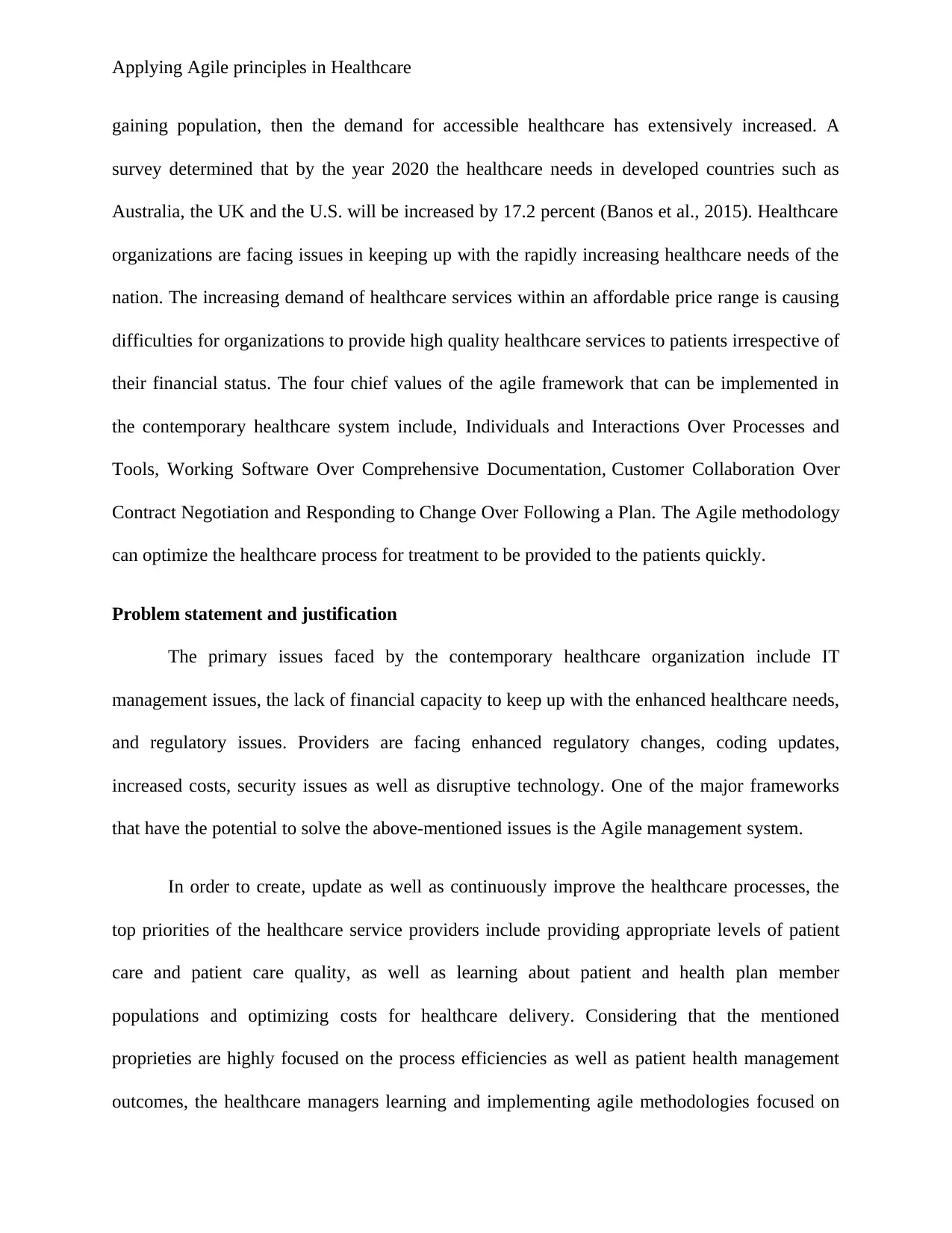
Applying Agile principles in Healthcare
gaining population, then the demand for accessible healthcare has extensively increased. A
survey determined that by the year 2020 the healthcare needs in developed countries such as
Australia, the UK and the U.S. will be increased by 17.2 percent (Banos et al., 2015). Healthcare
organizations are facing issues in keeping up with the rapidly increasing healthcare needs of the
nation. The increasing demand of healthcare services within an affordable price range is causing
difficulties for organizations to provide high quality healthcare services to patients irrespective of
their financial status. The four chief values of the agile framework that can be implemented in
the contemporary healthcare system include, Individuals and Interactions Over Processes and
Tools, Working Software Over Comprehensive Documentation, Customer Collaboration Over
Contract Negotiation and Responding to Change Over Following a Plan. The Agile methodology
can optimize the healthcare process for treatment to be provided to the patients quickly.
Problem statement and justification
The primary issues faced by the contemporary healthcare organization include IT
management issues, the lack of financial capacity to keep up with the enhanced healthcare needs,
and regulatory issues. Providers are facing enhanced regulatory changes, coding updates,
increased costs, security issues as well as disruptive technology. One of the major frameworks
that have the potential to solve the above-mentioned issues is the Agile management system.
In order to create, update as well as continuously improve the healthcare processes, the
top priorities of the healthcare service providers include providing appropriate levels of patient
care and patient care quality, as well as learning about patient and health plan member
populations and optimizing costs for healthcare delivery. Considering that the mentioned
proprieties are highly focused on the process efficiencies as well as patient health management
outcomes, the healthcare managers learning and implementing agile methodologies focused on
gaining population, then the demand for accessible healthcare has extensively increased. A
survey determined that by the year 2020 the healthcare needs in developed countries such as
Australia, the UK and the U.S. will be increased by 17.2 percent (Banos et al., 2015). Healthcare
organizations are facing issues in keeping up with the rapidly increasing healthcare needs of the
nation. The increasing demand of healthcare services within an affordable price range is causing
difficulties for organizations to provide high quality healthcare services to patients irrespective of
their financial status. The four chief values of the agile framework that can be implemented in
the contemporary healthcare system include, Individuals and Interactions Over Processes and
Tools, Working Software Over Comprehensive Documentation, Customer Collaboration Over
Contract Negotiation and Responding to Change Over Following a Plan. The Agile methodology
can optimize the healthcare process for treatment to be provided to the patients quickly.
Problem statement and justification
The primary issues faced by the contemporary healthcare organization include IT
management issues, the lack of financial capacity to keep up with the enhanced healthcare needs,
and regulatory issues. Providers are facing enhanced regulatory changes, coding updates,
increased costs, security issues as well as disruptive technology. One of the major frameworks
that have the potential to solve the above-mentioned issues is the Agile management system.
In order to create, update as well as continuously improve the healthcare processes, the
top priorities of the healthcare service providers include providing appropriate levels of patient
care and patient care quality, as well as learning about patient and health plan member
populations and optimizing costs for healthcare delivery. Considering that the mentioned
proprieties are highly focused on the process efficiencies as well as patient health management
outcomes, the healthcare managers learning and implementing agile methodologies focused on
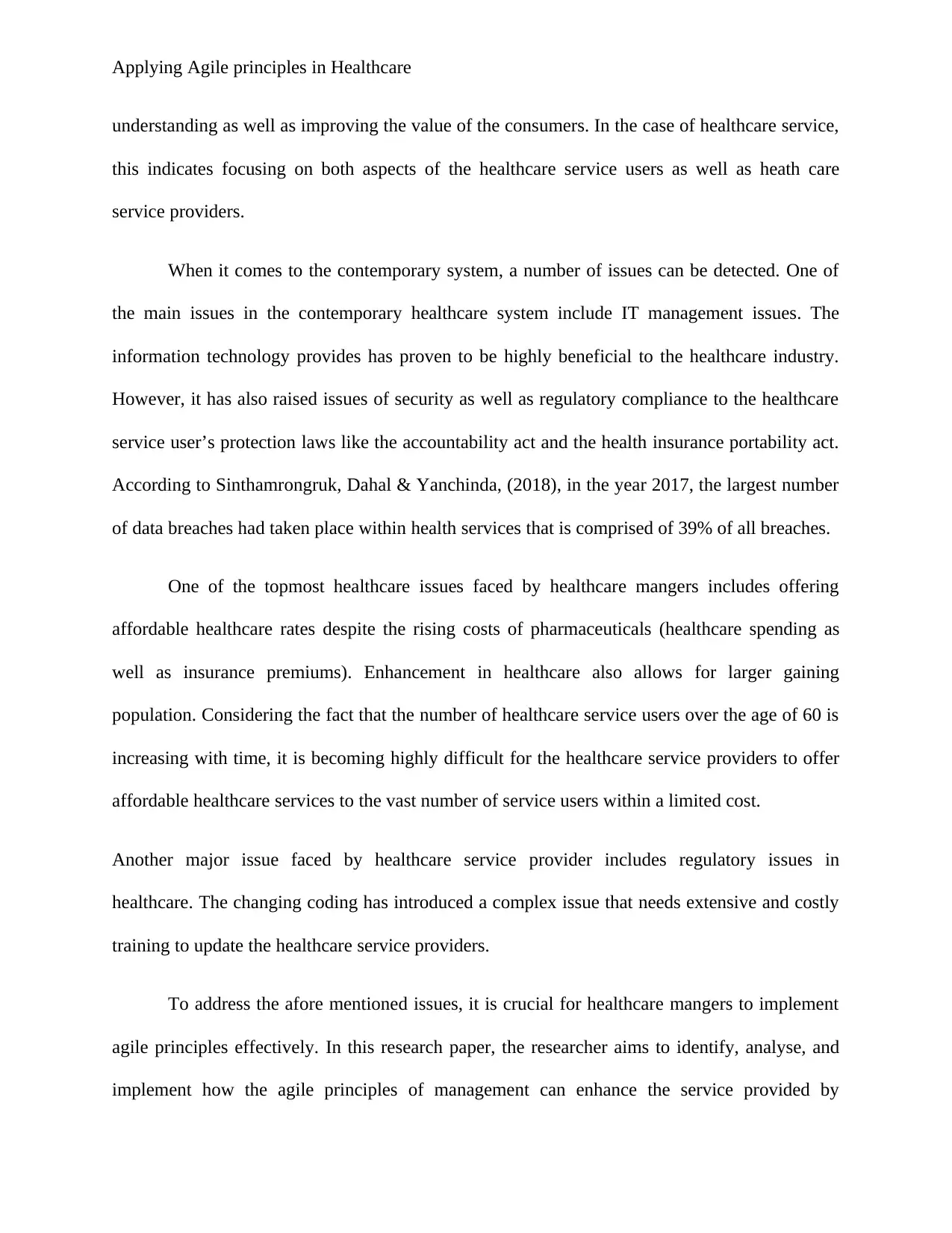
Applying Agile principles in Healthcare
understanding as well as improving the value of the consumers. In the case of healthcare service,
this indicates focusing on both aspects of the healthcare service users as well as heath care
service providers.
When it comes to the contemporary system, a number of issues can be detected. One of
the main issues in the contemporary healthcare system include IT management issues. The
information technology provides has proven to be highly beneficial to the healthcare industry.
However, it has also raised issues of security as well as regulatory compliance to the healthcare
service user’s protection laws like the accountability act and the health insurance portability act.
According to Sinthamrongruk, Dahal & Yanchinda, (2018), in the year 2017, the largest number
of data breaches had taken place within health services that is comprised of 39% of all breaches.
One of the topmost healthcare issues faced by healthcare mangers includes offering
affordable healthcare rates despite the rising costs of pharmaceuticals (healthcare spending as
well as insurance premiums). Enhancement in healthcare also allows for larger gaining
population. Considering the fact that the number of healthcare service users over the age of 60 is
increasing with time, it is becoming highly difficult for the healthcare service providers to offer
affordable healthcare services to the vast number of service users within a limited cost.
Another major issue faced by healthcare service provider includes regulatory issues in
healthcare. The changing coding has introduced a complex issue that needs extensive and costly
training to update the healthcare service providers.
To address the afore mentioned issues, it is crucial for healthcare mangers to implement
agile principles effectively. In this research paper, the researcher aims to identify, analyse, and
implement how the agile principles of management can enhance the service provided by
understanding as well as improving the value of the consumers. In the case of healthcare service,
this indicates focusing on both aspects of the healthcare service users as well as heath care
service providers.
When it comes to the contemporary system, a number of issues can be detected. One of
the main issues in the contemporary healthcare system include IT management issues. The
information technology provides has proven to be highly beneficial to the healthcare industry.
However, it has also raised issues of security as well as regulatory compliance to the healthcare
service user’s protection laws like the accountability act and the health insurance portability act.
According to Sinthamrongruk, Dahal & Yanchinda, (2018), in the year 2017, the largest number
of data breaches had taken place within health services that is comprised of 39% of all breaches.
One of the topmost healthcare issues faced by healthcare mangers includes offering
affordable healthcare rates despite the rising costs of pharmaceuticals (healthcare spending as
well as insurance premiums). Enhancement in healthcare also allows for larger gaining
population. Considering the fact that the number of healthcare service users over the age of 60 is
increasing with time, it is becoming highly difficult for the healthcare service providers to offer
affordable healthcare services to the vast number of service users within a limited cost.
Another major issue faced by healthcare service provider includes regulatory issues in
healthcare. The changing coding has introduced a complex issue that needs extensive and costly
training to update the healthcare service providers.
To address the afore mentioned issues, it is crucial for healthcare mangers to implement
agile principles effectively. In this research paper, the researcher aims to identify, analyse, and
implement how the agile principles of management can enhance the service provided by
⊘ This is a preview!⊘
Do you want full access?
Subscribe today to unlock all pages.

Trusted by 1+ million students worldwide
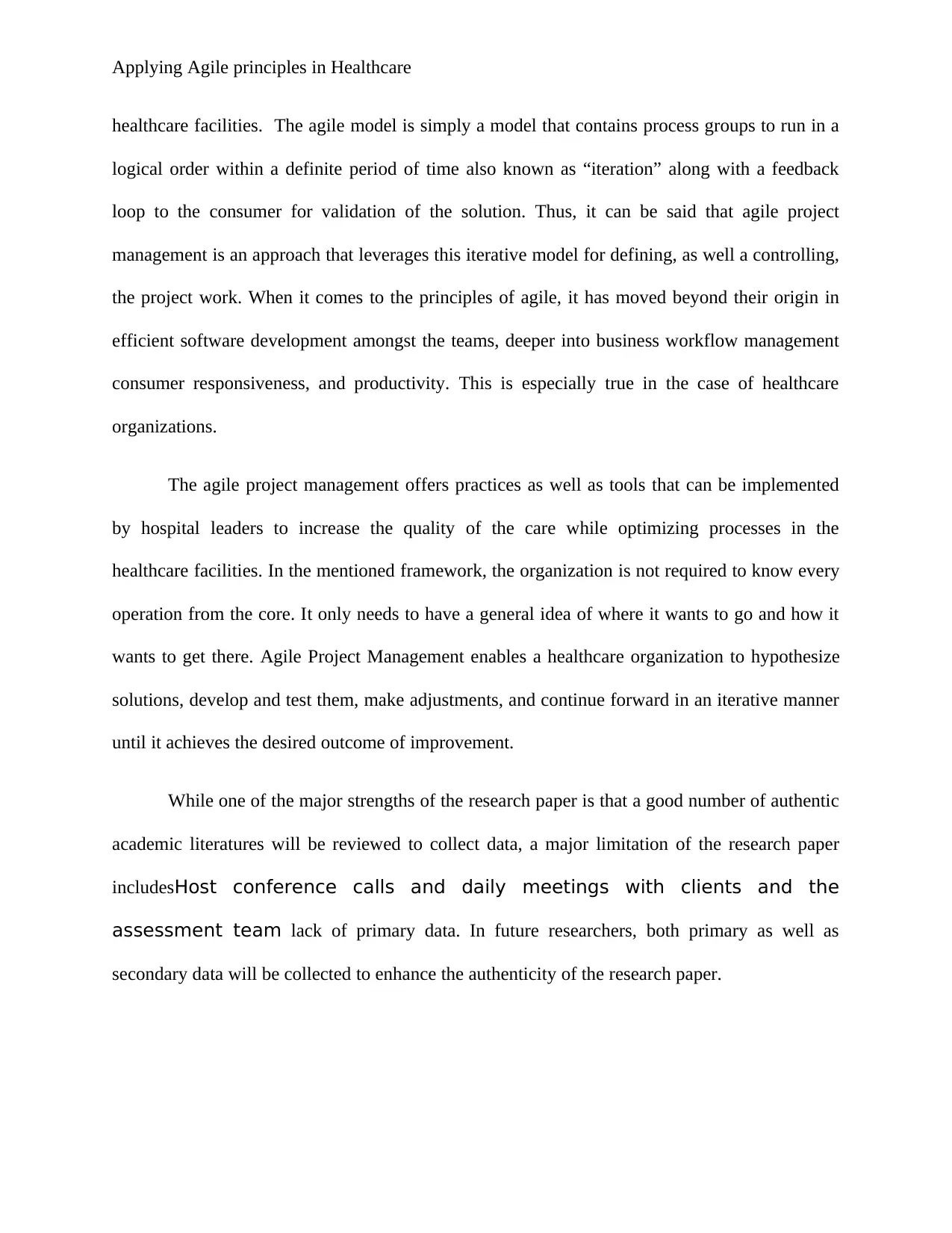
Applying Agile principles in Healthcare
healthcare facilities. The agile model is simply a model that contains process groups to run in a
logical order within a definite period of time also known as “iteration” along with a feedback
loop to the consumer for validation of the solution. Thus, it can be said that agile project
management is an approach that leverages this iterative model for defining, as well a controlling,
the project work. When it comes to the principles of agile, it has moved beyond their origin in
efficient software development amongst the teams, deeper into business workflow management
consumer responsiveness, and productivity. This is especially true in the case of healthcare
organizations.
The agile project management offers practices as well as tools that can be implemented
by hospital leaders to increase the quality of the care while optimizing processes in the
healthcare facilities. In the mentioned framework, the organization is not required to know every
operation from the core. It only needs to have a general idea of where it wants to go and how it
wants to get there. Agile Project Management enables a healthcare organization to hypothesize
solutions, develop and test them, make adjustments, and continue forward in an iterative manner
until it achieves the desired outcome of improvement.
While one of the major strengths of the research paper is that a good number of authentic
academic literatures will be reviewed to collect data, a major limitation of the research paper
includesHost conference calls and daily meetings with clients and the
assessment team lack of primary data. In future researchers, both primary as well as
secondary data will be collected to enhance the authenticity of the research paper.
healthcare facilities. The agile model is simply a model that contains process groups to run in a
logical order within a definite period of time also known as “iteration” along with a feedback
loop to the consumer for validation of the solution. Thus, it can be said that agile project
management is an approach that leverages this iterative model for defining, as well a controlling,
the project work. When it comes to the principles of agile, it has moved beyond their origin in
efficient software development amongst the teams, deeper into business workflow management
consumer responsiveness, and productivity. This is especially true in the case of healthcare
organizations.
The agile project management offers practices as well as tools that can be implemented
by hospital leaders to increase the quality of the care while optimizing processes in the
healthcare facilities. In the mentioned framework, the organization is not required to know every
operation from the core. It only needs to have a general idea of where it wants to go and how it
wants to get there. Agile Project Management enables a healthcare organization to hypothesize
solutions, develop and test them, make adjustments, and continue forward in an iterative manner
until it achieves the desired outcome of improvement.
While one of the major strengths of the research paper is that a good number of authentic
academic literatures will be reviewed to collect data, a major limitation of the research paper
includesHost conference calls and daily meetings with clients and the
assessment team lack of primary data. In future researchers, both primary as well as
secondary data will be collected to enhance the authenticity of the research paper.
Paraphrase This Document
Need a fresh take? Get an instant paraphrase of this document with our AI Paraphraser
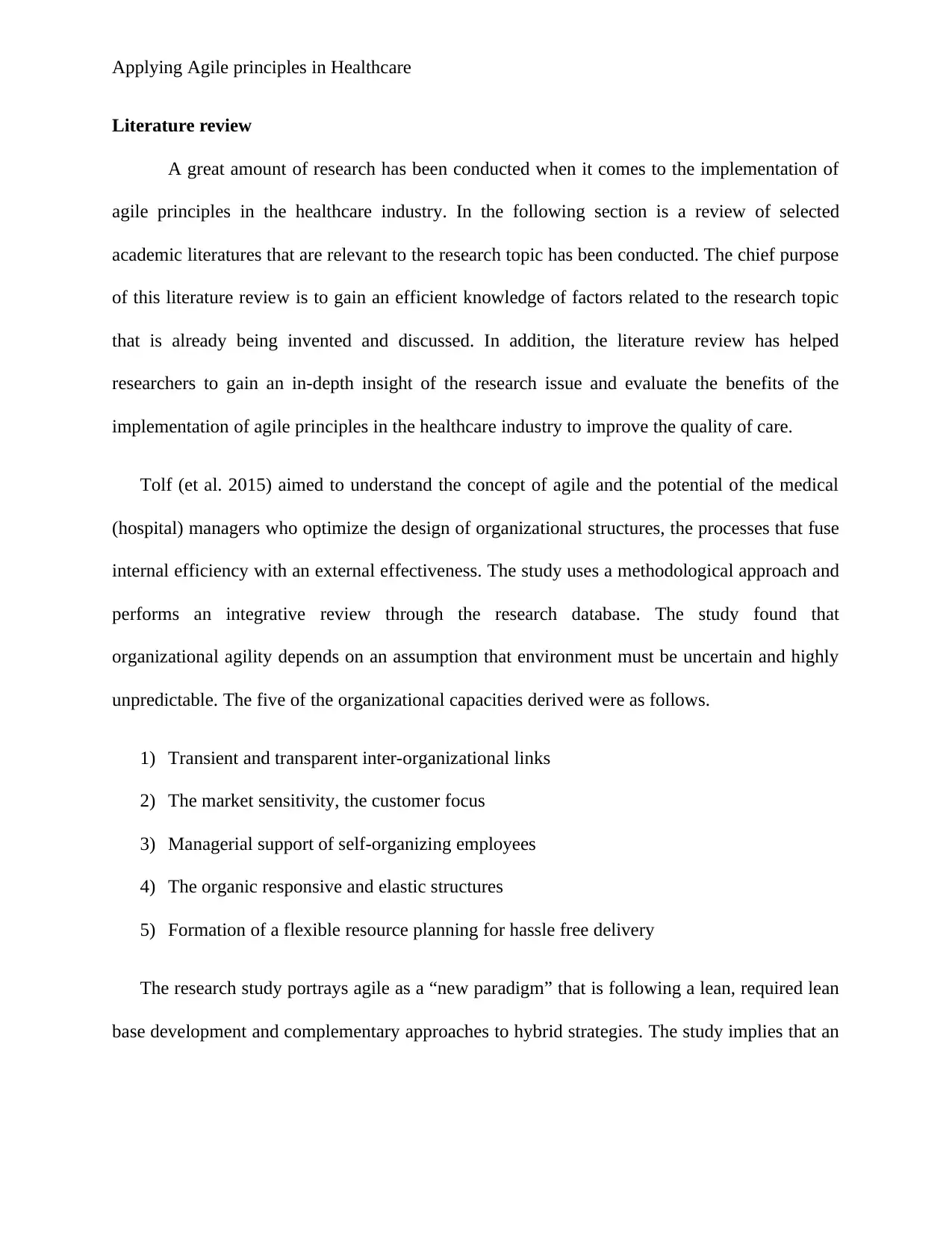
Applying Agile principles in Healthcare
Literature review
A great amount of research has been conducted when it comes to the implementation of
agile principles in the healthcare industry. In the following section is a review of selected
academic literatures that are relevant to the research topic has been conducted. The chief purpose
of this literature review is to gain an efficient knowledge of factors related to the research topic
that is already being invented and discussed. In addition, the literature review has helped
researchers to gain an in-depth insight of the research issue and evaluate the benefits of the
implementation of agile principles in the healthcare industry to improve the quality of care.
Tolf (et al. 2015) aimed to understand the concept of agile and the potential of the medical
(hospital) managers who optimize the design of organizational structures, the processes that fuse
internal efficiency with an external effectiveness. The study uses a methodological approach and
performs an integrative review through the research database. The study found that
organizational agility depends on an assumption that environment must be uncertain and highly
unpredictable. The five of the organizational capacities derived were as follows.
1) Transient and transparent inter-organizational links
2) The market sensitivity, the customer focus
3) Managerial support of self-organizing employees
4) The organic responsive and elastic structures
5) Formation of a flexible resource planning for hassle free delivery
The research study portrays agile as a “new paradigm” that is following a lean, required lean
base development and complementary approaches to hybrid strategies. The study implies that an
Literature review
A great amount of research has been conducted when it comes to the implementation of
agile principles in the healthcare industry. In the following section is a review of selected
academic literatures that are relevant to the research topic has been conducted. The chief purpose
of this literature review is to gain an efficient knowledge of factors related to the research topic
that is already being invented and discussed. In addition, the literature review has helped
researchers to gain an in-depth insight of the research issue and evaluate the benefits of the
implementation of agile principles in the healthcare industry to improve the quality of care.
Tolf (et al. 2015) aimed to understand the concept of agile and the potential of the medical
(hospital) managers who optimize the design of organizational structures, the processes that fuse
internal efficiency with an external effectiveness. The study uses a methodological approach and
performs an integrative review through the research database. The study found that
organizational agility depends on an assumption that environment must be uncertain and highly
unpredictable. The five of the organizational capacities derived were as follows.
1) Transient and transparent inter-organizational links
2) The market sensitivity, the customer focus
3) Managerial support of self-organizing employees
4) The organic responsive and elastic structures
5) Formation of a flexible resource planning for hassle free delivery
The research study portrays agile as a “new paradigm” that is following a lean, required lean
base development and complementary approaches to hybrid strategies. The study implies that an
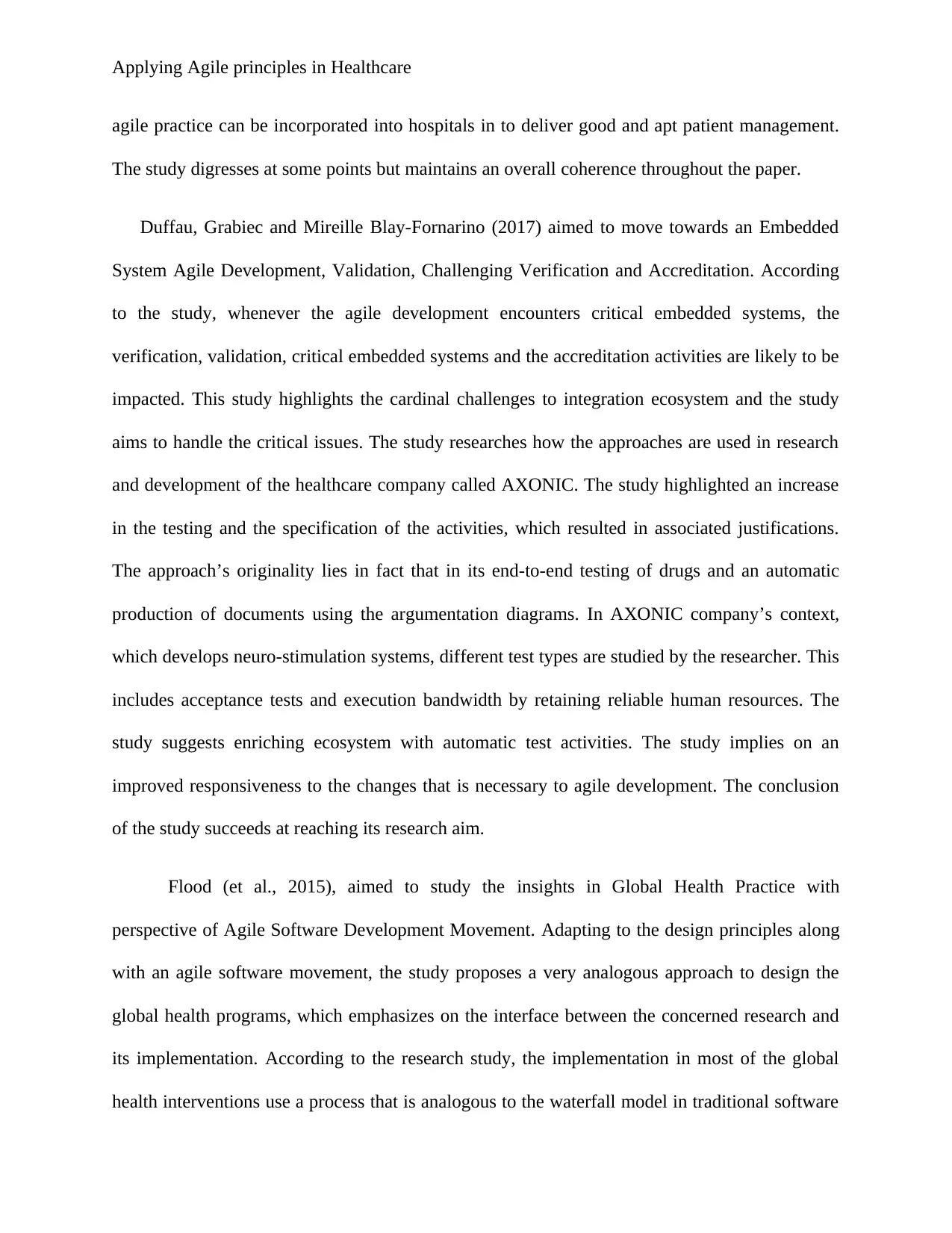
Applying Agile principles in Healthcare
agile practice can be incorporated into hospitals in to deliver good and apt patient management.
The study digresses at some points but maintains an overall coherence throughout the paper.
Duffau, Grabiec and Mireille Blay-Fornarino (2017) aimed to move towards an Embedded
System Agile Development, Validation, Challenging Verification and Accreditation. According
to the study, whenever the agile development encounters critical embedded systems, the
verification, validation, critical embedded systems and the accreditation activities are likely to be
impacted. This study highlights the cardinal challenges to integration ecosystem and the study
aims to handle the critical issues. The study researches how the approaches are used in research
and development of the healthcare company called AXONIC. The study highlighted an increase
in the testing and the specification of the activities, which resulted in associated justifications.
The approach’s originality lies in fact that in its end-to-end testing of drugs and an automatic
production of documents using the argumentation diagrams. In AXONIC company’s context,
which develops neuro-stimulation systems, different test types are studied by the researcher. This
includes acceptance tests and execution bandwidth by retaining reliable human resources. The
study suggests enriching ecosystem with automatic test activities. The study implies on an
improved responsiveness to the changes that is necessary to agile development. The conclusion
of the study succeeds at reaching its research aim.
Flood (et al., 2015), aimed to study the insights in Global Health Practice with
perspective of Agile Software Development Movement. Adapting to the design principles along
with an agile software movement, the study proposes a very analogous approach to design the
global health programs, which emphasizes on the interface between the concerned research and
its implementation. According to the research study, the implementation in most of the global
health interventions use a process that is analogous to the waterfall model in traditional software
agile practice can be incorporated into hospitals in to deliver good and apt patient management.
The study digresses at some points but maintains an overall coherence throughout the paper.
Duffau, Grabiec and Mireille Blay-Fornarino (2017) aimed to move towards an Embedded
System Agile Development, Validation, Challenging Verification and Accreditation. According
to the study, whenever the agile development encounters critical embedded systems, the
verification, validation, critical embedded systems and the accreditation activities are likely to be
impacted. This study highlights the cardinal challenges to integration ecosystem and the study
aims to handle the critical issues. The study researches how the approaches are used in research
and development of the healthcare company called AXONIC. The study highlighted an increase
in the testing and the specification of the activities, which resulted in associated justifications.
The approach’s originality lies in fact that in its end-to-end testing of drugs and an automatic
production of documents using the argumentation diagrams. In AXONIC company’s context,
which develops neuro-stimulation systems, different test types are studied by the researcher. This
includes acceptance tests and execution bandwidth by retaining reliable human resources. The
study suggests enriching ecosystem with automatic test activities. The study implies on an
improved responsiveness to the changes that is necessary to agile development. The conclusion
of the study succeeds at reaching its research aim.
Flood (et al., 2015), aimed to study the insights in Global Health Practice with
perspective of Agile Software Development Movement. Adapting to the design principles along
with an agile software movement, the study proposes a very analogous approach to design the
global health programs, which emphasizes on the interface between the concerned research and
its implementation. According to the research study, the implementation in most of the global
health interventions use a process that is analogous to the waterfall model in traditional software
⊘ This is a preview!⊘
Do you want full access?
Subscribe today to unlock all pages.

Trusted by 1+ million students worldwide
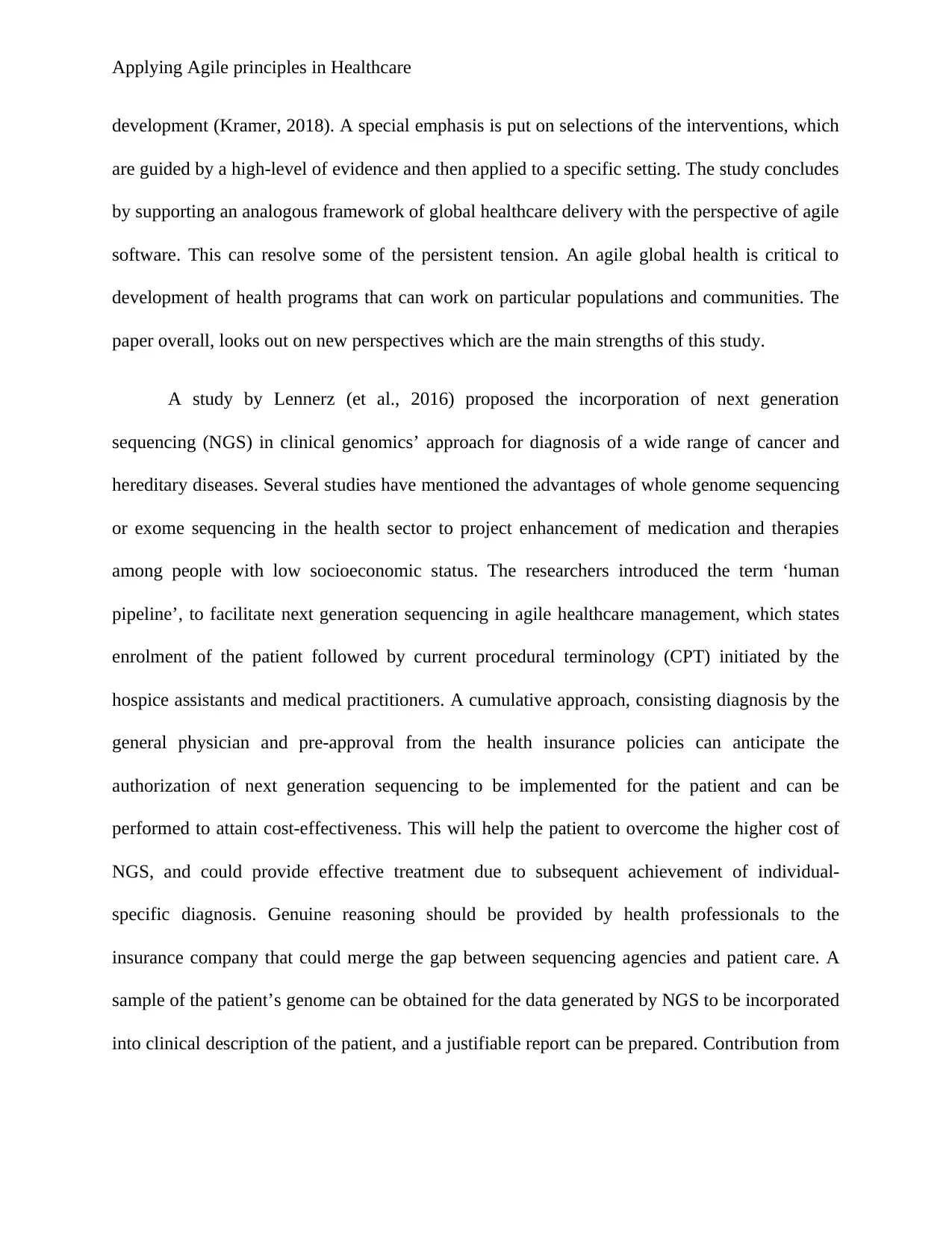
Applying Agile principles in Healthcare
development (Kramer, 2018). A special emphasis is put on selections of the interventions, which
are guided by a high-level of evidence and then applied to a specific setting. The study concludes
by supporting an analogous framework of global healthcare delivery with the perspective of agile
software. This can resolve some of the persistent tension. An agile global health is critical to
development of health programs that can work on particular populations and communities. The
paper overall, looks out on new perspectives which are the main strengths of this study.
A study by Lennerz (et al., 2016) proposed the incorporation of next generation
sequencing (NGS) in clinical genomics’ approach for diagnosis of a wide range of cancer and
hereditary diseases. Several studies have mentioned the advantages of whole genome sequencing
or exome sequencing in the health sector to project enhancement of medication and therapies
among people with low socioeconomic status. The researchers introduced the term ‘human
pipeline’, to facilitate next generation sequencing in agile healthcare management, which states
enrolment of the patient followed by current procedural terminology (CPT) initiated by the
hospice assistants and medical practitioners. A cumulative approach, consisting diagnosis by the
general physician and pre-approval from the health insurance policies can anticipate the
authorization of next generation sequencing to be implemented for the patient and can be
performed to attain cost-effectiveness. This will help the patient to overcome the higher cost of
NGS, and could provide effective treatment due to subsequent achievement of individual-
specific diagnosis. Genuine reasoning should be provided by health professionals to the
insurance company that could merge the gap between sequencing agencies and patient care. A
sample of the patient’s genome can be obtained for the data generated by NGS to be incorporated
into clinical description of the patient, and a justifiable report can be prepared. Contribution from
development (Kramer, 2018). A special emphasis is put on selections of the interventions, which
are guided by a high-level of evidence and then applied to a specific setting. The study concludes
by supporting an analogous framework of global healthcare delivery with the perspective of agile
software. This can resolve some of the persistent tension. An agile global health is critical to
development of health programs that can work on particular populations and communities. The
paper overall, looks out on new perspectives which are the main strengths of this study.
A study by Lennerz (et al., 2016) proposed the incorporation of next generation
sequencing (NGS) in clinical genomics’ approach for diagnosis of a wide range of cancer and
hereditary diseases. Several studies have mentioned the advantages of whole genome sequencing
or exome sequencing in the health sector to project enhancement of medication and therapies
among people with low socioeconomic status. The researchers introduced the term ‘human
pipeline’, to facilitate next generation sequencing in agile healthcare management, which states
enrolment of the patient followed by current procedural terminology (CPT) initiated by the
hospice assistants and medical practitioners. A cumulative approach, consisting diagnosis by the
general physician and pre-approval from the health insurance policies can anticipate the
authorization of next generation sequencing to be implemented for the patient and can be
performed to attain cost-effectiveness. This will help the patient to overcome the higher cost of
NGS, and could provide effective treatment due to subsequent achievement of individual-
specific diagnosis. Genuine reasoning should be provided by health professionals to the
insurance company that could merge the gap between sequencing agencies and patient care. A
sample of the patient’s genome can be obtained for the data generated by NGS to be incorporated
into clinical description of the patient, and a justifiable report can be prepared. Contribution from
Paraphrase This Document
Need a fresh take? Get an instant paraphrase of this document with our AI Paraphraser
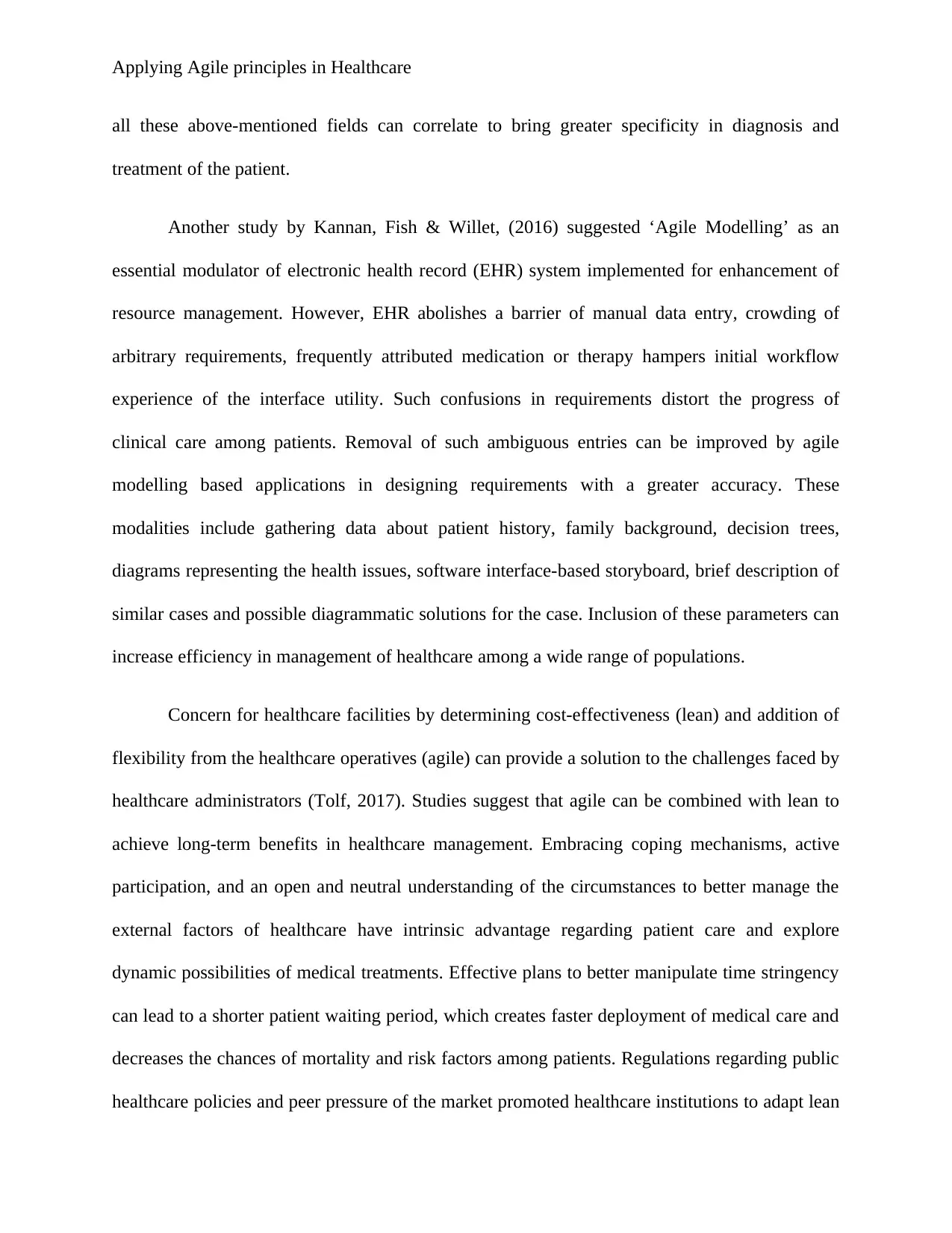
Applying Agile principles in Healthcare
all these above-mentioned fields can correlate to bring greater specificity in diagnosis and
treatment of the patient.
Another study by Kannan, Fish & Willet, (2016) suggested ‘Agile Modelling’ as an
essential modulator of electronic health record (EHR) system implemented for enhancement of
resource management. However, EHR abolishes a barrier of manual data entry, crowding of
arbitrary requirements, frequently attributed medication or therapy hampers initial workflow
experience of the interface utility. Such confusions in requirements distort the progress of
clinical care among patients. Removal of such ambiguous entries can be improved by agile
modelling based applications in designing requirements with a greater accuracy. These
modalities include gathering data about patient history, family background, decision trees,
diagrams representing the health issues, software interface-based storyboard, brief description of
similar cases and possible diagrammatic solutions for the case. Inclusion of these parameters can
increase efficiency in management of healthcare among a wide range of populations.
Concern for healthcare facilities by determining cost-effectiveness (lean) and addition of
flexibility from the healthcare operatives (agile) can provide a solution to the challenges faced by
healthcare administrators (Tolf, 2017). Studies suggest that agile can be combined with lean to
achieve long-term benefits in healthcare management. Embracing coping mechanisms, active
participation, and an open and neutral understanding of the circumstances to better manage the
external factors of healthcare have intrinsic advantage regarding patient care and explore
dynamic possibilities of medical treatments. Effective plans to better manipulate time stringency
can lead to a shorter patient waiting period, which creates faster deployment of medical care and
decreases the chances of mortality and risk factors among patients. Regulations regarding public
healthcare policies and peer pressure of the market promoted healthcare institutions to adapt lean
all these above-mentioned fields can correlate to bring greater specificity in diagnosis and
treatment of the patient.
Another study by Kannan, Fish & Willet, (2016) suggested ‘Agile Modelling’ as an
essential modulator of electronic health record (EHR) system implemented for enhancement of
resource management. However, EHR abolishes a barrier of manual data entry, crowding of
arbitrary requirements, frequently attributed medication or therapy hampers initial workflow
experience of the interface utility. Such confusions in requirements distort the progress of
clinical care among patients. Removal of such ambiguous entries can be improved by agile
modelling based applications in designing requirements with a greater accuracy. These
modalities include gathering data about patient history, family background, decision trees,
diagrams representing the health issues, software interface-based storyboard, brief description of
similar cases and possible diagrammatic solutions for the case. Inclusion of these parameters can
increase efficiency in management of healthcare among a wide range of populations.
Concern for healthcare facilities by determining cost-effectiveness (lean) and addition of
flexibility from the healthcare operatives (agile) can provide a solution to the challenges faced by
healthcare administrators (Tolf, 2017). Studies suggest that agile can be combined with lean to
achieve long-term benefits in healthcare management. Embracing coping mechanisms, active
participation, and an open and neutral understanding of the circumstances to better manage the
external factors of healthcare have intrinsic advantage regarding patient care and explore
dynamic possibilities of medical treatments. Effective plans to better manipulate time stringency
can lead to a shorter patient waiting period, which creates faster deployment of medical care and
decreases the chances of mortality and risk factors among patients. Regulations regarding public
healthcare policies and peer pressure of the market promoted healthcare institutions to adapt lean
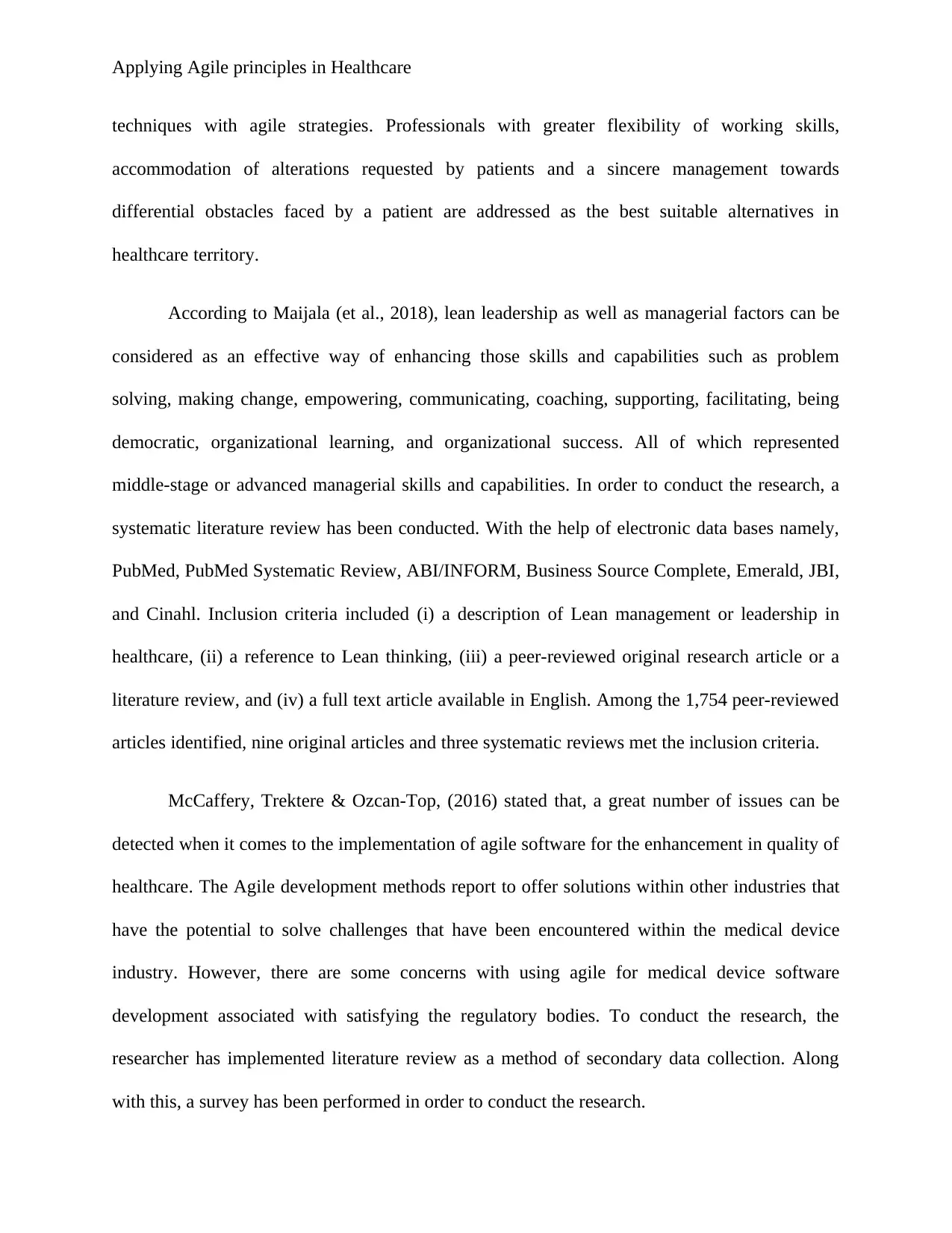
Applying Agile principles in Healthcare
techniques with agile strategies. Professionals with greater flexibility of working skills,
accommodation of alterations requested by patients and a sincere management towards
differential obstacles faced by a patient are addressed as the best suitable alternatives in
healthcare territory.
According to Maijala (et al., 2018), lean leadership as well as managerial factors can be
considered as an effective way of enhancing those skills and capabilities such as problem
solving, making change, empowering, communicating, coaching, supporting, facilitating, being
democratic, organizational learning, and organizational success. All of which represented
middle-stage or advanced managerial skills and capabilities. In order to conduct the research, a
systematic literature review has been conducted. With the help of electronic data bases namely,
PubMed, PubMed Systematic Review, ABI/INFORM, Business Source Complete, Emerald, JBI,
and Cinahl. Inclusion criteria included (i) a description of Lean management or leadership in
healthcare, (ii) a reference to Lean thinking, (iii) a peer-reviewed original research article or a
literature review, and (iv) a full text article available in English. Among the 1,754 peer-reviewed
articles identified, nine original articles and three systematic reviews met the inclusion criteria.
McCaffery, Trektere & Ozcan-Top, (2016) stated that, a great number of issues can be
detected when it comes to the implementation of agile software for the enhancement in quality of
healthcare. The Agile development methods report to offer solutions within other industries that
have the potential to solve challenges that have been encountered within the medical device
industry. However, there are some concerns with using agile for medical device software
development associated with satisfying the regulatory bodies. To conduct the research, the
researcher has implemented literature review as a method of secondary data collection. Along
with this, a survey has been performed in order to conduct the research.
techniques with agile strategies. Professionals with greater flexibility of working skills,
accommodation of alterations requested by patients and a sincere management towards
differential obstacles faced by a patient are addressed as the best suitable alternatives in
healthcare territory.
According to Maijala (et al., 2018), lean leadership as well as managerial factors can be
considered as an effective way of enhancing those skills and capabilities such as problem
solving, making change, empowering, communicating, coaching, supporting, facilitating, being
democratic, organizational learning, and organizational success. All of which represented
middle-stage or advanced managerial skills and capabilities. In order to conduct the research, a
systematic literature review has been conducted. With the help of electronic data bases namely,
PubMed, PubMed Systematic Review, ABI/INFORM, Business Source Complete, Emerald, JBI,
and Cinahl. Inclusion criteria included (i) a description of Lean management or leadership in
healthcare, (ii) a reference to Lean thinking, (iii) a peer-reviewed original research article or a
literature review, and (iv) a full text article available in English. Among the 1,754 peer-reviewed
articles identified, nine original articles and three systematic reviews met the inclusion criteria.
McCaffery, Trektere & Ozcan-Top, (2016) stated that, a great number of issues can be
detected when it comes to the implementation of agile software for the enhancement in quality of
healthcare. The Agile development methods report to offer solutions within other industries that
have the potential to solve challenges that have been encountered within the medical device
industry. However, there are some concerns with using agile for medical device software
development associated with satisfying the regulatory bodies. To conduct the research, the
researcher has implemented literature review as a method of secondary data collection. Along
with this, a survey has been performed in order to conduct the research.
⊘ This is a preview!⊘
Do you want full access?
Subscribe today to unlock all pages.

Trusted by 1+ million students worldwide
1 out of 19
Related Documents
Your All-in-One AI-Powered Toolkit for Academic Success.
+13062052269
info@desklib.com
Available 24*7 on WhatsApp / Email
![[object Object]](/_next/static/media/star-bottom.7253800d.svg)
Unlock your academic potential
Copyright © 2020–2025 A2Z Services. All Rights Reserved. Developed and managed by ZUCOL.





